Pride parade
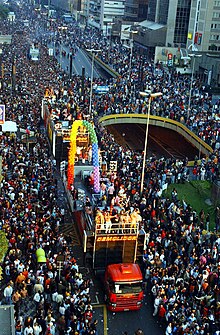
A pride parade is part of a festival or ceremony held by the Lesbian, Gay, Bisexual and Transgender community of a city to commemorate the struggle for LGBT rights and LGBT pride. [1]
The LGBT community of a city will typically present an annual parade, sometimes in the context of a longer celebration including performances, dances, street parties, and the like. Most LGBT pride parades take place in the middle of the year, particularly in June, to commemorate the Stonewall riots.
History
Early in the morning of June 28, 1969 lesbian, gay, bisexual, transgender and queer persons rioted following a police raid on the Stonewall Inn, a gay bar that was heavily patronize by people of colour including a high percentage of drag queens in the Greenwich Village section of New York City. [2] The Stonewall riots are generally considered to be the beginning of the modern LGBT rights movement, as it was the first time in modern history that a significant body of LGBT people resisted arrest. Given the population that frequented the establishment, a large percentage of the people who initially fought back were persons of colour.
On Sunday, June 28, 1970, the one-year anniversary of the riots, the Gay Liberation Front organized a march, coordinated by Brenda Howard, from Greenwich Village to Central Park in New York City in commemoration of the Stonewall riots. [3] On the same weekend gay activist groups on the West Coast of the United States held a march in Los Angeles and a march and 'Gay-in' in San Francisco [4].
The first marches were both serious and fun, and served to inspire the widening activist movement; they were repeated in the following years, and more and more annual marches started up in other cities throughout the world.
In New York and Atlanta the marches were called 'Gay Liberation Marches', and the day of celebration was called "Gay Liberation Day"; in San Francisco and Los Angeles they became known as 'Gay Freedom Marches' and the day was called "Gay Freedom Day". As more towns and cities began holding their own celebrations, these names spread.
In the 1980s there was a cultural shift in the gay movement. Activists of a less radical nature began taking over the March committees in different cities, and they dropped "Gay Liberation" and "Gay Freedom" from the names, replacing them with "Gay Pride" under pressure from more conservative segments of the LGBT community.

Many parades still have at least some of the original political or activist character, especially in less LGBT-positive settings. However, in more gay-positive cities, the parades take on a festive or even Mardi Gras-like character. Large parades often involve floats, dancers, drag queens, and amplified music; but, even such celebratory parades usually include political and educational contingents, such as local politicians and marching groups from queer institutions of various kinds. Other typical parade participants include local LGBT-friendly churches such as Metropolitan Community Churches and Unitarian Universalist Churches, PFLAG (Parents and Friends of Lesbians and Gays), and the LGBT employee associations from large businesses.
Even the most festive parades usually offer some aspect dedicated to remembering victims of AIDS and anti-LGBT violence. Some particularly important pride parades are funded by governments and corporate sponsors, and promoted as major tourist attractions for the cities that host them. In some countries, some pride parades are now also called Pride Festivals. Some of these festivals provide a carnival-like atmosphere in a nearby park or city-provided closed-off street, with information booths, music concerts, barbecues, beer stands, contests, sports, and games.
Though the reality was that the Stonewall riots themselves as well as the immediate and the ongoing political organizing that occurred following them were events that were fully participated in by Lesbian women, Bisexual people [1], Transgender people[2][3] as well as by Gay men of all races and backgrounds, historically these events were first named Gay, the word at that time being used in a more generic sense to cover the entire spectrum of what is now variously called the 'Queer', GLBT or LGBT community.
By the late 70's and early 80's as many of the actual participants had grown older, moved on to other issues or passed away this led to misunderstandings as to who had actually participated in Stonewall riots, who had actually organized the subsequent demonstrations, marches and memorials and who had been members of early activist organizations such as Gay Liberation Front and Gay Activists Alliance.
But eventually the language caught up with the reality of the community and the names have become more accurate and inclusive. Though these changes met with initial resistance from some in their own communities who were unaware of the actual historical facts [4]. Changing first to Lesbian and Gay, today most are called Lesbian, Gay, Bisexual and Transgender (LGBT).
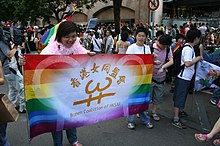
The rainbow flag, sometimes called 'the Freedom Flag', was first used to symbolize gay struggles for liberation and gay diversity by artist Gilbert Baker at a Gay Freedom Day parade in San Francisco in 1978, and is now commonly displayed in LGBT pride parades throughout the world. As of 2003, it consists of six colored stripes of red, orange, yellow, green, blue, and violet. The different colors symbolize diversity in the gay community. [5]
Opposition
A portion of the LGBT and heterosexual populations regard pride parades, especially those of a more festive character, as vulgar flaunting of sexual orientation, charging them with an undue emphasis on sex and bizarre behaviour, which they see as detrimental to the cause of LGBT rights. The argument's sometimes taken further, arguing that they expose the "gay community" to ridicule, depicting them as emasculated "half-men".[citation needed]
Others criticize this position, seeing it as pandering to homophobia, and arguing that heterosexuality takes centre stage the other 364 days of the year and that pride parades promote visibility and discussion of gay, lesbian, bisexual and transgender issues. Most argue that such parades are carnivals and that they should be taken as such rather than as representative of everyday life for someone who happens to a member of the LGBT community.
Those who take socially conservative political positions are sometimes opposed to such events because they view them to be indecent and contrary to public morality. This belief is partly based on certain things sometimes found in the parades, such as public nudity, S & M paraphanelia, and other highly sexualized features.
Notable pride events
This section needs expansion. You can help by adding to it. |
Belgrade
On June 30, 2001 several LGBTQ groups from Serbia attempted to march through Belgrade's streets and peacefully demand their rights and an end to oppression. The event was registered with the local police for safety reasons and according to the law, however, when the people started to gather in one of the city's principal squares, a huge crowd of soccer fans, clerics leading ultra nationalist youth, and skinheads stormed the event, attacked and seriously injured several participants and stopped the manifestation from taking place. The event was extremely tense as the police was not equipped to suppress riots or protect the Pride marchers. The conflict unravelled in the streets of Belgrade as the opposers of the event took to the streets triumphantly singing songs about killing gays and lesbians. Some of the victims of the attack took refuge in the building of the student cultural centre where a discussion was planned following the Pride event. The building was surrounded as well in attempt to stop the forum from happening, and it was successful. There were harder clashes between poorly equipped police and assilants in the area where several police officers were injured as well. The aftermath was characterized by sharp criticizm of the assilants and government and security officials from the NGO's and a number of public personalities. Government officials did not particularly comment on the event nor were there any consequences for some 30 young men arrested in the riots. Serbia remains a hostile environment for the LGBTQ population and all attempts to organize subsequent Pride marches failed. This was the first Pride march organized in this region.
Jerusalem
On June 30 2005, a parade took place in Jerusalem. It had originally been prohibited by a municipal ban, which was canceled by the court. During the parade, a young ultra-Orthodox Jewish man tried to murder 3 people with a kitchen knife.
Latvia
On July 22, 2005, the first Latvian gay pride march took place in Riga, surrounded by protesters. It had previously been banned by the city council, and the Prime Minister of Latvia, Aigars Kalvītis, opposed the event, stating Riga should "not promote things like that", however a court decision allowed the march to go ahead [5].
Taipei
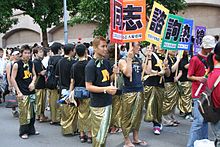
On November 1, 2003 the first gay pride parade in the Chinese region was held in Taipei, with over 1,000 people attending [7], and the mayor of Taipei, Ma Ying-jeou, attended the event. Homosexuality remains a taboo in Taiwan, and many participants wore masks to hide their identities.
International Yearly Pride Events
Africa
- Cape Town, South Africa
- Johannesburg, South Africa
Asia
- Taipei, ROC (Taiwan) (Taiwan Pride)
Europe

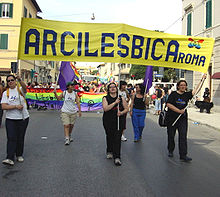
- Amsterdam, Netherlands (Amsterdam Gay Pride)
- Berlin, Germany (Christopher Street Day)
- Birmingham, UK (Birmingham Pride)
- Brighton, UK (Brighton Pride)
- Bucharest, Romania (GayFest)
- Budapest, Hungary (Budapest Pride)
- Cologne, Germany (Cologne Gay Pride)
- Dublin, Ireland (Dublin Pride)
- Leicester, UK (Leicester Pride)
- Lisbon, Portugal
- London, UK
- Madrid, Spain
- Manchester, UK
- Paris, France
- Reykjavík, Iceland (Hinsegin dagar - Reykjavík Gay Pride)
- Stockholm, Sweden (Stockholm Pride)
- Warsaw, Poland (Parada Rownosci)
- Zagreb, Croatia (Zagreb Pride)
- Any European City (Europride)
Latin America
- Buenos Aires, Argentina
- Brasília, Brazil
- Rio de Janeiro, Brazil
- São Paulo, Brazil (Parada do Orgulho GLBT de São Paulo)
- Lima, Peru (Marcha de Orgullo)
- Mexico City, Mexico
- Guadalajara, Mexico
- San Juan, Puerto Rico
Middle East
- Tel Aviv, Israel
North America
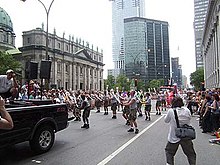
- Atlanta, Georgia, USA (Atlanta Pride)
- Boston, Massachusetts, USA (Boston Pride)
- Calgary, Alberta, Canada (Pride Calgary)
- Chicago, Illinois, USA (Chicago Pride Parade)
- Cincinnati, Ohio, USA
- Columbus, Ohio, USA
- Denver, Colorado, USA (PrideFest Denver)
- Houston, Texas, USA (Pride Houston)
- Long Beach, California, USA
- Montreal, Quebec, Canada (Divers/Cité)
- New York City, New York, USA (Heritage of Pride)
- Philadelphia, Pennsylvania, USA
- Portland, Oregon, USA (Pride Northwest)
- St. Louis, Missouri, USA (PrideFest)
- Salt Lake City, Utah, USA (Utah Pride Festival)
- San Francisco, California, USA (San Francisco Pride)
- Seattle, Washington, USA (Seattle Out & Proud)
- Toronto, Ontario, Canada (Gay Pride Week)
- Vancouver, British Columbia, Canada(Vancouver Pride Week)
- Victoria, British Columbia, Canada
- Washington, D.C., USA (Capital Pride)
- West Hollywood, California, USA
- Winnipeg, Manitoba, Canada
Oceania
- Singapore (Indignation)
- Sydney, Australia (Sydney Gay and Lesbian Mardi Gras)
See also
| Part of a series on |
| LGBTQ rights |
|---|
 |
| Lesbian ∙ Gay ∙ Bisexual ∙ Transgender ∙ Queer |
|
|
- Stonewall Riots
- Brenda Howard
- Sylvia Rivera
- Marsha P. Johnson
- Dyke March
- Gay pride
- Sexuality and gender identity-based cultures
- Rainbow flag
External links
- Europride Parade London 2006 photo gallery
- Amsterdam Gay Pride Parade photo gallery
- Gay Pride France and Europe photos 2006
